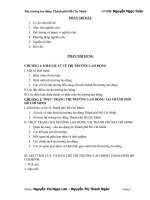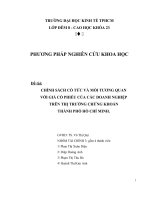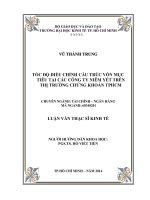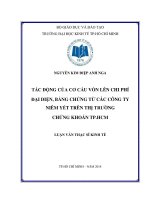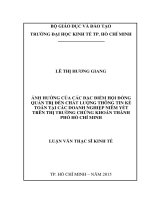Thị trường lao động Thành phố Hồ Chí Minh trong hội nhập quốc tế (tt)
Bạn đang xem bản rút gọn của tài liệu. Xem và tải ngay bản đầy đủ của tài liệu tại đây (304.57 KB, 26 trang )
MINISTRY OF EDUCATION AND TRAINING
UNIVERSITY OF ECONOMICS HO CHI MINH CITY
-----***-----
PHAM THI LY
Ho Chi Minh Labor Market in International
Integration
Specialization: Political Economy
Code: 62310102
Supervisor:
Doctor Luu Thị Kim Hoa
Associate Professor Nguyen Chi Hai
DOCTORAL THESIS SUMMARY
HO CHI MINH CITY, FEBRUARY, 2018
2
FORWORD
1. Reasons for selecting the topic
Vietnam is intergrating into the world economy, the development
of labor market is considered as an important element to enhance the
competitiveness of the economy in the global playground. On the other
hand, the process of international integration also brings opportunities
and challenges for Vietnam labor market. Therefore, how has Vietnam
labor market developed in the context of integration and what policies
need to promote the development of the labor market in order to
improve competitiveness, promote economic growth and ensure
sustainable employment?. In order to answer these question, we chose
to study the topic of "Ho Chi Minh Labor Market in International
Integration". We chose to study the labor market in Ho Chi Minh City
because this is the pioneering local about labor market relation, and this
is the place where concentrate the largest labor supply.
2. Objectives and tasks of research.
2.1. Objectives of research.
The general objective of the thesis is to provide scientific and
practical arguments for the movement and development of the labor
market; and propose the views, orientations and policies for
development of the labor market in HCMC in the context of
international integration.
2.2. Taks of research.
The research tasks of the dissertation are research papers with the
same topic and systematize theories on labor market, determining the
research gap, forming the methodological background and analytical
framework for the topic; analyze the reality and identify the factors
affect the results of HCMC labor market in the process of international
integration in recent years; evaluating the achievements and limitations
of HCMC labor market; forecasting the opportunities and challenges of
the HCMC labor marke in the process of integration, thence forming
views, proposing orientations and systematic policy solutions to
develop HCMC labor market.
3. Object and scope of research.
3.1. Object of research.
The object of the thesis is "Labor market”
3
3.2. Scope of research.
The thesis studies the labor market in the context of international
integration in terms of political economy, within HCMC since 1995,
especially since 2007 when Vietnam became a member of WTO.
4. New contribution of the dissertation
Firstly, theoretical contributions: The thesis applies the theory of
labor market of Marxist political economy and modern political
economy in order to analyze the impact of internal factors and
international integration factors on results of the labor market;
Secondly, practical contributions: The thesis shows the main
outcomes of the labor market and analyzes the internal factors of the
economy and international integration affecting these key results; to
determine the achievements and limitations of HCMC labor market; to
forecast the opportunities and challenges of the HCMC labor marke in
the process of integration; to propose solutions for the development of
HCMC labor market based on scientific and practical background.
5. Structure of the dissertation
The dissertation includes: Introduction, 5 chapters, Conclusions,
Reference List and Appendix
Chapter 1
OVERVIEW OF RESEARCH
1.1.
Overview of research on labor market in abroad
In this section, this dessertation summarizes a number of researches
on labor market in transition economies, such as China, Eastern
Europe. And the thesis also summarizes some studies on labor markets
in developing countries in the context of globalization
1.2.
Overview of research on labor market in Vietnam
In this section, the dissertation focuses on a number of studies on
labor market in Vietnam and HCMC in the context of international
integration.
1.3.
Overall assessment of the relevant research
In analyzing labor market, both domestic and foreign researches
refer to three basic factors of the labor market: labor supply, labor
demand and wages. Labor market, on the one hand, operating according
to the objective laws of the market, on the other hand, it needs the
regulation and management of the State. The nature of the labor market
may have different perspectives, but both economic theory and
4
empirical research highlight the role of labor markets and labor market
policies in the economy. Labor market development policies aim to
effectively utilize human resources to promote economic growth,
enhance the competitiveness of the economy, ensure full employment,
sustainability and high productivity in the integration process. Most
researches have different approaches and conclusions, but all agree that
labor markets are one of the main channels affected by integration, the
context of regionalization and globalization. The degree of impact of
the integration process on the labor market in different countries is
different because it is unique. In order to develop the labor market,
there should be coordination of policies at the national and regional
level. Labor market studies in Vietnam have also shown achievements
and constraints, suggesting that the integration process has both
positive and negative impacts on the labor market.
However, the research gap is still very broad and needs to be further
researched: the labor market studies in the country do not specify in
detail what factors affect the movement and distribution. development
of the labor market; The studies on labor market in limited scope,
smaller areas are very few, especially the study of labor market by
region and territory of the country; Some researches on labor market in
Ho Chi Minh City have not studied comprehensive labor market in
HCMC in the context of international integration. In addition, most of
the major studies focus on just one aspect of the labor market, such as
labor market research in the context of micro-level economic transition
(enterprise), or study the impact of policies on the development of the
labor market. At the same time, most studies on labor markets in
Vietnam or within HCMC were conducted in the period before 2007,
when Vietnam was not fully integrated into the world economy. As a
result, the analysis and policy implications may no longer be relevant
to the current context.
5
Chapter 2
THEORETICAL BACKGROUND OF LABOR MARKET IN
INTERNATIONAL INTERGRATION
2.1.
The basic theoretical issues on labor market
2.1.1. The concept of labor market
The concept of labor market can be interpreted in the following
ways:
Firstly, in terms of space: the labor market is an interactive space
between buyers and sellers of labor to agree on wages, working
conditions, working time, etc.
Secondly, in terms of essence: the labor market is a category of
production relations, expressing the relationship between workers and
employers in the process of producing, distributing, exchanging and
consuming labor power
Thirdly, in terms of operating mechanism: the labor market is part
of the synchronous system of markets, so it is influenced by the
objective laws in the market economy and the regulation of the State.
2.1.2. Theory of labor goods of Marx
In this section, the thesis focuses on Marx's theory of labor goods,
including: the concept of labor, the condition of labor becoming goods,
the two attributes of labor goods is the value and use value. This section
also analyzes Marx's theory of wages, distinguishing between nominal
wages and real wages.
2.1.3. The rules of operation of the labor market
Like any other market, the labor market operates under the objective
laws of the market, in which value is considered the basic economic
rule. In addition, the impact of supply-demand law and competition law
has led to the results of the labor market, including wages, employment
and unemployment.
2.1.4. Theory of employment and unemployment
In this section, the thesis systematically summarizes some of the
typical theories of employment and unemployment, including the
theory of employment and unemployment in some political economics
schools such as Marx, Classical and New Classics and J.M. Keynes
theory.
6
2.2.
Labor market in international integration
2.2.1. Impact of the internal factors inside the economy on the
labor market
The development of the labor market is influenced by many factors
in the economy. In our opinion, there are a number of key factors:
demography, growth and economic structural change, education and
training, institutions and policies of the State, the system of labor
market services.
2.2.2. Impact of international integration on the labor market
The labor market is not only influenced by factors inside the
economy but also influenced by the factors of international integration.
Trade liberalization and foreign direct investment actually affect the
results of the labor market. However, this impact on wages and
employment is the difference between the subjects in terms of skill
level, industry, business sector.
2.2.3. The role of labor market in economic growth and
international integration
The labor market can facilitate or limit the growth of the economy
as this is the input market for the production process. This is an
important market in synchronous systems of market types of market
economy. In addition, the results of the labor market such as quantity
and quality of labor supply, labor price, etc. also directly affect the
import and export of goods, foreign direct investment and the
competitiveness of the economy in the increasingly international
competitive environment. Therefore, the development of labor market
plays the role of ensuring full and sustainable employment for workers;
promote economic growth and improve the competitiveness of the
economy in the context of international integration and fair distribution,
ensuring social security for workers.
7
2.3.
Suggested analytical framework for the dissertation
Labor market:
Impact of the internal
factors inside the economy
on the labor market
-
Demography
Growth and economic
structural change
Education and training
Institutions and policies
of the State
The system of labor
Policies
Policy on labor demand
The policy of
economic
structural
change
associated with
transformation
of economic
growth model.
- The policy
of enterprise
development
- Policy for
the informal
sector
-Export
promotion
policy
market services
Labor market
-
Supply and demand of
labor
Competition on labor
market
Employment and
unemployment
Wages
International integration
Trade
- Investment
- Labor movement
-
Policy on labor supply
-Improving the quality of human
resources
-Improving the efficiency of
labor supply management
Policy on labor market:
-Legal framework of the labor
market
-Wage policy
-Policy linking supply and
demand of labor
Chapter 3
-
Target
-Effective
allocation of
human
resources.
-Improving the
competitivene
ss
of
the
economy.
-Equitable
distribution
and
risk
mitigation in
the
labor
market.
8
RESEARCH METHODS
3.1. Research approach
The research subject of the dissertation belongs to political
economics, therefore, the author uses the " Materialistic Dialectical
Method" and the "Scientific Abstraction Method" as the main method
of study. The basic principles or requirements of the method are
described in detail in this part of the thesis.
3.2. Specific research methods
To conduct research, the thesis uses a combination of qualitative and
quantitative methods
3.2.1. Qualitative research methods
The thesis uses qualitative methods: historical overview method,
event study method, comparative method and analytical and synthesis
method.
3.2.2. Quantitative research methods
Descriptive statistics are used to collect, describe and analyze data
on the economic structure, supply and demand for labor, wages,
employment and unemployment on the labor market in Ho Chi Minh
City.
The statistical test (t-test and ANOVA) is used to evaluate and
compare the variables of labor and income of employees who work in
firms with and without import-export activities, FDI enterprises and
other business areas i�������������������������������������������������������������������������������������������������������������������������������������������������������������������������������������������������������������������������������������������������������������������������������������������������������������������������������������������������������������������������������������������������������������������������������������������������������������������������������������������������������������������������������������������������������������������������������������������������������������������������������������������������������������������������������������������������������������������������������������������������������������������������������������������������������������������������������������������������������������������������������������������������������������������������������������������������������������������������������������������������������������������������������������������������������������������������������������������������������������������������������������������������������������������������������������������������������������������������������������������������������������������������������������������������������������������������������������������������������������������������������������������������������������������������������������������������������������������������������������������������������������������������������������������������������������������������������������������������������������������������������������������������������������������������������������������������������������������������������������������������������������������������������������������������������������������������������������������������������������������������������������������������������������������������������������������������������������������������������������������������������������������������������������������������������������������������������������������������������������������������������������������������������������������������������������������������������������������������������������������������������������������������������������������������������������������������������������������������������������������������������������������������������������������������������������������������������������������������������������������������������������������������������������������������������������������������������������������������������������������������������������������������������������������������������������������������������������������������������������������������������������������������������������������������������������������������������������������������������������������������������������������������������������������������������������������������������������������������������������������������������������������������������������������������������������������������������������������������������������������������������������������������������������������������������������������������������������������������������������������������������������������������������������������������������������������������������������������������������������������������������������������������������������������������������������������������������������������������������������������������������������������������������������������������������������������������������������������������������������������������������������������������������������������������������������������������������������������������������������������������������������������������������������������������������������������������������������������������������������������������������������������������������������������������������������������������������������������������������������������������������������������������������������������������������������������������������������������������������������������������������������������������������������������������������������������������������������������������������������������������������������������������������������������������������������������������������������������������������������������������������������������������������������������������������������������������������������������������������������������������������������������������������������������������������������������������������������������������������������������������������������������������������������������������������������������������������������������������������������������������������������������������������������������������������������������������������������������������������������������������������������������������������������������������������������������������������������������������������������������������������������������������������������������������������������������������������������������������������������������������������������������������������������������������������������������������������������������������������������������������������������������������������������������������������������������������������������������������������������������������������������������������������������������������������������������������������������������������������������������������������������������������������������������������������������������������������������������������������������������������������������������������������������������������������������������������������������������������������������������������������������������������������������������������������������������������������������������������������������������������������������������������������������������������������������������������������������������������������������������������������������������������������������������������������������������������������������������������������������������������������������������������������������������������������������������������������������������������������������������������������������������������������������������������������������������������������������������������������������������������������������������������������������������������������������������������������������������������������������������������������������������������������������������������������������������������������������������������������������������������������������������������������������������������������������������������������������������������������������������������������������������������������������������������������������������������������������������������������������������������������������������������������������������������������������������������������������������������������������������������������������������������������������������������������������������������������������������������������������������������������������������������������������������������������������������������������������������������������������������������������������������������������������������������������������������������������������������������������������������������������������������������������������������������������������������������������������������������������������������������������������������������������������������������������������������������������������������������������������������������������������������������������������������������������������������������������������������������������������������������������������������������������������������������������������������������������������������������������������������������������������������������������������������������������������������������������������������������������������������������������������������������������������������������������������������������������������������������������������������������������������������������������������������������������������������������������������������������������������������������������������������������������������������������������������������������������������������������������������������������������������������������������������������������������������������������������������������������������������������������������������������������������������������������������������������������������������������������������������������������������������������������������������������������������������������������������������������������������������������������������������������������������������������������������������������������������������������������������������������������������������������������������������������������������������������������������������������������������������������������������������������������������������������������������������������������������������������������������������������������������������������������������������������������������������������������������������������������������������������������������������������������������������������������������������������������������������������������������������������������������������������������������������������������������������������������������������������������������������������������������������������������������������������������������������������������������������������������������������������������������������������������������������������������������������������������������������������������������������������������������������������������������������������������������������������������������������������������������������������������������������������������������������������������������������������������������������������������������������������������������������������������������������������������������������������������������������������������������������������������������������������������������������������������������������������������������������������������������������������������������������������������������������������������������������������������������������������������������������������������������������������������������������������������������������������������������������������������������������������������������������������������������������������������������������������������������������������������������������������������������������������������������������������������������������������������������������������������������������������������������������������������������������������������������������������������������������������������������������������������������������������������������������������������������������������������������������������������������������������������������������������������������������������������������������������������������������������������������������������������������������������������������������������������������������������������������������������������������������������������������������������������������������������������������������������������������������������������������������������������������������������������������������������������������������������������������������������������������������������������������������������������������������������������������������������������������������������������������������������������������������������������������������������������������������������������������������������������������������������������������������������������������������������������������������������������������������������������������������������������������������������������������������������������������������������������������������������������������������������������������������������������������������������������������������������������������������������������������������������������������������������������������������������������������������������������������������������������������������������������������������������������������������������������������������������������������������������������������������������������������������������������������������������������������������������������������������������������������������������������������������������������������������������������������������������������������������������������������������������������������������������������������������������������������������������������������������������������������������������������������������������������������������������������������������������������������������������������������������������������������������������������������������������������������������������������������������������������������������������������������������������������������������������������������������������������������������������������������������������������������������������������������������������������������������������������������������������������������������������������������������������������������������������������������������������������������������������������������������������������������������������������������������������������������������������������������������������������������������������������������������������������������������������������������������������������������������������������������������������������������������������������������������������������������������������������������������������������������������������������������������������������������������������������������������������������������������������������������������������������������������������������������������������������������������������������������������������������������������������������������������������������������������������������������������������������������������������������������������������������������������������������������������������������������������������������������������������������������������������������������������������������������������������������������������������������������������������������������������������������������������������������������������������������������������������������������������������������������������������������������������������������������������������������������������������������������������������������������������������������������������������������������������������������������������������������������������������������������������������������������������������������������������������������������������������������������������������������������������������������������������������������������������������������������������������������������������������������������������������������������������������������������������������������������������������������������������������������������������������������������������������������������������������������������������������������������������������������������������������������������������������������������������������������������������������������������������������������������������������������������������������������������������������������������������������������������������������������������������������������������������������������������������������������������������������������������������������������������������������������������������������������������������������������������������������������������������������������������������������������������������������������������������������������������������������������������������������������������������������������������������������������������������������������������������������������������������������������������������������������������������������������������������������������������������������������������������������������������������������������������������������������������������������������������������������������������������������������������������������������������������������������������������������������������������������������������������������������������������������������������������������������������������������������������������������������������������������������������������������������������������������������������������������������������������������������������������������������������������������������������������������������������������������������������������������������������������������������������������������������������������������������������������������������������������������������������������������������������������������������������������������������������������������������������������������������������������������������������������������������������������������������������������������������������������������������������������������������������������������������������������������������������������������������������������������������������������������������������������������������������������������������������������������������������������������������������������������������������������������������������������������������������������������������������������������������������������������������������������������������������������������������������������������������������������������������������������������������������������������������������������������������������������������������������������������������������������������������������������������������������������������������������������������������������������������������������������������������������������������������������������������������������������������������������������������������������������������������������������������������������������������������������������������������������������������������������������������������������������������������������������������������������������������������������������������������������������������������������������������������������������������������������������������������������������������������������������������������������������������������������������������������������������������������������������������������������������������������������������������������������������������������������������������������������������������������������������������������������������������������������������������������������������������������������������������������������������������������������������������������������������������������������������������������������������������������������������������������������������������������������������������������������������������������������������������������������������������������������������������������������������������������������������������������������������������������������������������������������������������������������������������������������������������������������������������������������������������������������������������������������������������������������������������������������������������������������������������������������������������������������������������������������������������������������������������������������������������������������������������������������������������������������������������������������������������������������������������������������������������������������������������������������������������������������������������������������������������������������������������������������������������������������������������������������������������������������������������������������������������������������������������������������������������������������������������������������������������������������������������������������������������������������������������������������������������������������������������������������������������������������������������������������������������������������������������������������������������������������������������������������������������������������������������������������������������������������������������������������������������������������������������������������������������������������������������������������������������������������������������������������������������������������������������������������������������������������������������������������������������������������������������������������������������������������������������������������������������������������������������������������������������������������������������������������������������������������������������������������������������������������������������������������������������������������������������������������������������������������������������������������������������������������������������������������������������������������������������������������������������������������������������������������������������������������������������������������������������������������������������������������������������������������������������������������������������������������� is statistically significant. Export-import enterprises not
only have a larger labor size than non-import-export enterprises but
also have higher capital-intensive levels. Comparing the average
capital per employee of the import-export enterprises is higher than that
of the other enterprises. The wages of workers in export enterprises are
generally higher than the wages of employees working in non-export
enterprises.
4.5. A general assessment of the achievements and limitations of
the HCMC labor market in international integration
4.5.1. Achievements and causes
The results of analyzing the real situation of HCMC labor market in
the process of international integration show that the labor market in
Ho Chi Minh City has achieved the following achievements:
Firstly, the labor supply of the City is large. Compared to the general
level of the country, the quality of labor has been constantly improved.
This is one of the advantages that help Ho Chi Minh City become
attractive destinations of domestic and foreign investors.
Secondly, the structure of labor demand shifts positively. Due to the
demand of economic restructuring from simple labor-intensive
industries to capital-intensive industries, demand for skilled labor is
increasing.
Thirdly, the unemployment rate and underemployment rate tend to
decrease.
18
The incidence of wage labor in HCMC has been increasing, and this is
the region with the highest rate, indicating the development of labor
market in the city.
Fourthly, wages are determined on the basis of the value of labor
and the fluctuation of labor supply and demand in the market. Average
wages tend to increase in line with economic growth and labor
productivity growth.
Fifthly, in recent years, the labor productivity of HCMC has tended
to increase rapidly and much higher than the labor productivity of the
whole country.
Sixthly, the system linking labor supply and demand has been built
and developed, which is quite effective in helping to connect supply
and demand of labor better and better
Seventhly, the institution of the labor market and the policies of the
State for the labor market are increasingly being improved, ensuring
the operation of the labor market in accordance with the objective laws
of the market.
Eighthly, international integration has had a positive impact on the
labor market in Ho Chi Minh City.
Cause of achievement: Ho Chi Minh City is the place where the
market economy developed early; The City Government is very active
to seize the opportunity from the integration process; There are many
policies to improve the institutional system of labor market in line with
international practices; there is a connection between labor supply and
demand through employment services; the private sector and the
foreign invested economic sector have developed strongly; the
development of high quality human resources is valued. At the same
time, dynamic economic development has attracted a large number of
high quality migrant workers.
4.5.2. Limitations and reasons
In addition to the achievements, the overall assessment of the labor
market in Ho Chi Minh City has limitations in the process of
integration, that is:
Firstly, the labor supply is plentiful, the rate of training is high but
the skills of the workers are weak. This also leads to an imbalance in
labor supply and supply, while labor supply is excessive, but labor that
meets technical requirements is lacking in many sectors.
Secondly, unskilled labor demand tends to decrease rapidly but still
accounts for the highest proportion of total labor demand.
19
Third, labor productivity is lower than other countries in the region,
which is a big challenge for HCMC in competing with the cities in the
region and economic structural change according to modern trends.
Fourthly, temporary employment and informal employment tended
to increase while the social security system did not cover the workforce
in this area. This is a vulnerable group in the integration process.
Fifthly, the labor market still has the segment of wages by gender,
economic sector, etc.
Sixthly, labor disputes and strikes have been reduced but still quite
tense, the efficiency of labor law enforcement is still poor.
Causes of restriction: economic restructuring is slow, quality growth
and competitiveness is not high; The legal framework governing the
operation of the labor market has not kept pace with the requirements,
enforcement of labor relations institutions is weak; vocational guidance
system, employment services, labor market information and education
and training have many inadequacies, lack of effective link between the
training and the use of human resources, etc. Employment policies still
focus mainly on job creation by width rather than on quality of
employment, labor productivity growth and income improvement.
20
Chapter 5
OBSERVATIONS, DIRECTIONS AND SOLUTIONS FOR
DEVELOPING THE LABOR MARKET IN HCMC IN THE
INTERNATIONAL NTEGRATION
5.1. Viewpoints and orientations to develop Ho Chi Minh City's
labor market in international integration
5.1.1. Forecasting the opportunities and challenges of the
HCMC labor market in international integration
Opportunities
Firstly, the process of international integration continues to create a
driving force for labor market reforms to integrate into the labor market
of the region and the world.
Secondly, international integration creates opportunities for
increasing labor demand, thus creating more jobs for workers.
Thirdly, there are opportunities to improve the quality of labor
supply to improve competitiveness.
Fourthly, there are opportunities to raise wages and incomes for
workers, especially skilled workers.
Fifthly, there are opportunities to improve labor relations, improve
working conditions, and develop social security systems that help to
ensure the legitimate rights and interests of workers in accordance with
international commitments.
Challenges
Firstly, high quality labor moves out of the labor market in HCMC.
Second, there is a risk of rising unemployment or low quality
employment, increased vulnerability.
Thirdly, wage segmentation and income divide may increase
Fourth, there are challenges in the implementation of international
labor standards.
5.1.2. Viewpoints and orientations to develop Ho Chi Minh
City's labor market in international integration
Proposed solutions to develop the labor market in Ho Chi
Minh City
When proposing solutions to develop Ho Chi Minh City's labor
market, it is necessary to base on the view of respecting the
development rules of the labor market. Furthermore, it is necessary to
improve the management and regulation of the state in order to ensure
that the labor market operates efficiently. Ho Chi Minh City's labor
21
market development must be linked to the socio-economic
development orientation of the city in order to meet the objective of
transforming the growth model and raising the competitiveness of the
economy. In addition, government policies must ensure fairness for
actors that enter the labor market to promote both economic growth and
social justice. HCM's development policy needs to be set in the context
of domestic and international because Ho Chi Minh City is a market
economy developed strongly, having economic and cultural exchanges
with localities in the country and in other countries in the world.
Orientation to develop HCMC labor market in
international integration
Development orientation of labor market in Ho Chi Minh City by
2025 should continue to improve the legal framework and labor market
policies; to ensure the balance of labor supply-demand, to develop
formal jobs and support workers who work in the informal sector; to
focus on boosting labor demand in high technology industries and
services to improve labor productivity; to focus on human capital
investment to improve the quality of human resources, meet the needs
and take advantage of opportunities from international integration; to
build in a coordinated way the infrastructure of the labor market and to
provide effective public services; strengthen the social security system
for workers to prevent and overcome the risks of employment and
income of workers, to make labor market activities safer and more
efficient, minimize the risks for employees and vulnerability to external
shocks during integration.
5.2. Policy implications to develop HCMC's labor market in the
context of international integration
5.2.1. Solutions to labor supply
Solutions to improve the quality of human resources
Firstly, linking human development strategy and economic
development strategy.
Secondly, improve the quality of higher education and vocational
training for human resources development.
Thirdly, mobilize resources for investment in human resources
development.
Fourthly, enhance the responsibility and efficiency of state
management of human resource development.
Fifthly, raising social awareness on human resources development.
22
Solutions to improve the efficiency of the management of
migrant labor supply
Firstly, it is necessary to limit unskilled migrant workers and to
attract highly skilled workers by economic policies rather than
administrative measures.
Secondly, it is necessary to improve the efficiency of management
of migrant workers in the country in the direction of creating favorable
conditions and equality.
Thirdly, it is necessary to intensify measures to strictly control
foreign workers who migrate to Ho Chi Minh City.
5.2.2. Solutions to labor demand
The shift of economic structure and structure of labor
demand associated with transformation of growth model
First of all, it is necessary to limit the development of laborintensive industries step by step, shifting economic structure in
industries, focusing on the quality of growth on the basis of investing
in high added value chains in the value chain, developing highly
specialized labor-intensive industries, developing the industry based on
modern technology and equipment in order to raise productivity,
quality and efficiency.
The second is promoting economic structural change in the service
sector, giving priority to the development of high-level services such
as finance, science and technology, import-export services, health care
and education, etc, creating demand and expanding the capacity to
attract high quality labor in the country and abroad.
The third is to shift the agricultural structure towards high-tech
agriculture, biotechnology, seedling centers of the region and is the
place of export of agricultural products of the Southern major economic
area and the whole country.
Business development, informal sector support.
The first is to improve the business environment for enterprise
development, creating jobs for employees.
The second is to focus on developing policies to support and
develop small and medium enterprises to promote labor productivity
growth and improve the quality of employment and create incentives
for the development of the economy.
The third is to support the informal sector to make business
registration with the aim of improving working conditions and income;
to consult and support the informal sector to access credit to improve
23
labor productivity and improve working conditions in this area; to
encourage the informal sector to participate in production or
cooperative groups and support the development of businesses and
socio-economic organizations; to support the informal sector to access
the market, especially through the provision of market information.
5.2.3. Solutions on institutional improvement, labor market
policy
Improving the legal and institutional framework for the
labor market
Firstly, it is necessary to continue reviewing, amending and
supplementing the labor law system in line with international standards
on labor, employment and labor market, to comply with international
practices and commitments to ensure equal treatment between
employers and workers.
Secondly, it is necessary to intensify the supervision and inspection
of the enforcement of labor rights laws.
Thirdly, it is necessary to build a mechanism for cooperation,
dialogue, negotiation and agreement among parties in labor relations in
order to ensure the harmonious interests of the parties and the common
interests of the enterprises.
Fourthly, labor market institutions should continue to reform to
ensure increased flexibility in the labor market under the State's
regulation in conjunction with ensuring fair employment for workers.
Policy on linking supply and demand for labor
Firstly, it is necessary to continue to improve the institution and
policies and develop the employment service network as well as
vocational counseling services both broad and diversified so that
employees can easily access counseling and job referral services.
Second, employment channels need to be diversified. The system of
job exchanges should also be linked.
Thirdly, development of information system of labor market.
Improving the salary policy
Firstly, the wage policy must be linked to the socio-economic
development of the country, ensuring the principle of macro-balance
and maintaining the socio-political stability.
Secondly, the wage policy must be consistent with the socialist
market economy
24
Thirdly, wage policies must protect workers' rights, while also
ensuring the welfare of workers and employers.
Implementation of social security and support for
disadvantaged workers in labor market
First of all, HCMC needs to effectively implement the social
insurance policy, expand the coverage of compulsory social insurance
and voluntary social insurance; and improve the conditions of the social
insurance system to be more suitable for workers in the informal sector.
Secondly, the city must have a financial mobilization policy to
increase investment in the social security system.
Thirdly, the city needs to strengthen human resources, physical and
technical infrastructure to serve social welfare programs and policies.
Fourthly, the city needs to have policies to support retraining
workers who have lost their jobs due to the restructuring of the
economy before the requirements of integration.
CONCLUSION
Over 30 years of renovation and integration, Ho Chi Minh City's
labor market has been developing more and more. HCMC has the
largest labor supply in the country, with a high proportion of the
working-age population and is in the period of golden population
structure; the quality of labor supply is increasing. Labor demand in Ho
Chi Minh City also increased rapidly thanks to high economic growth
rate. Economic structure and labor structure shifted positively. Salaries
and wages are formed on the basis of agreement as required by the work
and the qualifications of the employees, reflecting more accurately
labor prices on the labor market. At the same time, international
integration and foreign direct investment also create jobs in the labor
market in HCMC; The average wage of workers in FDI enterprises,
import-export enterprises is higher than other enterprises and the
difference is statistically significant. In the process of integration,
HCMC's social labor productivity tends to increase rapidly and much
higher than that of the whole country; the labor supply-demand linkage
system has been developed and developed, helping to connect
employers and employees better and better. The labor market
institutions and policies of the State for the labor market are
increasingly being improved, ensuring the labor market to operate
25
flexibly according to the objective laws of the market. Therefore, it can
be confirmed that the labor market in HCM City has actively developed
in the process of international integration.
However, in the process of development, the labor market in HCM
City still shows weaknesses, such as abundant labor supply in quantity
but quality of labor is still low, this makes labor productivity in HCM
City is lower than other countries in the region. The supply-demand
imbalance has been occurring for many years, new jobs have been
increasing steadily over the years, but unemployment has been
increasing. Therefore, in order to improve labor market efficiency, it is
necessary to have a system of synchronous solutions: perfecting labor
market institutions, raising the quality of labor supply and increasing
labor demand, improving the quality of service system in the labor
market, etc. In particular, improving the quality of labor supply is
considered as the most important solution to improve the performance
of the labor market, contributing to promoting growth, enhancing the
competitiveness of the economy and raising the living standards of
workers.
Recommendations on further research directions
The labor market is a broad topic and can not be mentioned in the
context of the thesis, so the next research directions of the topic are:
- To study separately the connection between education and training
policies and policies on development of labor market.
- Further assessment of the impact of trade liberalization and foreign
investment on domestic labor mobility and international labor mobility.
- Do research on working conditions such as working time,
workplace safety, labor standards, labor relations, etc. In particular, we
believe that if we have enough information, we will analyze the impact
of trade liberalization and invest on the difference in employment and
wages of workers by sector, by job placement, by professional
qualification in the business sector to obtain a more comprehensive
assessment.
26
LIST OF PROJECTS AND RESEARCH PUBLISHED BY
AUTHOR RELATED TO THE THESIS TOPICS
A. THE ARTICLE PUBLISHED ON MAGAZINE
1. Pham Thi Ly (2017). Employment and income of employees
in foreign invested enterprises in Ho Chi Minh City. Journal of Science
and Technology, Vol. 20, p. 52-63, ISSN: 2588-1051
2. Pham Thi Ly, Nguyen Thi Dong (2017): The effects of
Vietnam’s economic restructuring on employment elasticity. Journal
of Development and Integration, Vol. 32, p. 56-61, ISSN: 1859-428.
3. Pham Thi Ly (2016). Vietnamese labor market when
participating TPP. Journal of Economics and Forecasting, 24, pp.3436, ISSN: 0866-7120.
4. Pham Thi Ly (2015). Vietnam Labor Market in ASEAN
Economic Community: Opportunities and Challenges ". Journal of
Political Science, Vol. 1, pp.34-41, ISSN: 1559-0187.
5. Pham Thi Ly (2012). Labor export in the context of current
Vietnamese economy and problems. Journal of Binhduong’s
Economics and Technology, No. 6, pp. 3-8.
6. Pham Thi Ly, Nguyen Thanh Trong (2012). Vietnam's current
human resources: Challenges to the economy and solutions for
development, Journal of Economic Development, Vol. 260, pp. 10-17,
ISSN: 185-1124.
7. Pham Thi Ly, Nguyen Thanh Trong (2017). Solutions to
improve the business environment for business development, Journal
of Economics and Forecasting, 17, pp. 19-21, ISSN: 0866-7120.
B. SCIENTIFIC RESEARCH PROJECTS
1. Pham Thi Ly, Nguyen Thi Dong (2017). Studying the impact
of economic restructuring on employment during economic growth in
Vietnam. Scientific research project at University level (Code:
CS2016-40), Ho Chi Minh City University of Economics.
2. Pham Thi Ly (2015). The impact of international economic
integration on labor market in Ho Chi Minh City. Scientific research
project at University level (Code: CS2014-89), University of
Economics of Ho Chi Minh City.
3. Nguyen Thanh Van (Chair), Pham Thi Ly (Member) (2010).
Promoting labor export in Ho Chi Minh City in the period of 2010 2020. Scientific research projects at ministerial level


